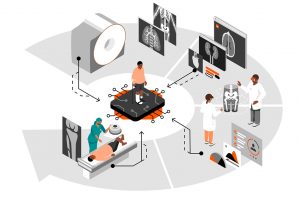Go beyond PACS – Discover ODIS

![]()
If you know better, you can do better. Over the past two decades, healthcare has undergone a rapid and far-reaching digital transformation. But digitalization has generated a new challenge: information overload. According to one estimate, the volume of healthcare-related data being generated digitally doubles every 73 days.1 Much of it is stored in discrete silos – such as DICOM images, ECGs or laboratory data – that make cross-system access difficult. And unfortunately, powerful diagnostic tools often lack interoperability. The result: instead of supporting informed and actionable decision-making, the digital revolution too often hinders more efficient diagnosis or improved patient care.2
To realize the true potential of the digital revolution, we must “only connect” the disparate parts of healthcare – facilitating seamless interoperability, open, secure data exchange and universal functionality across relevant areas of healthcare. The goal is to ensure that all relevant data is at hand when it is needed by patients, healthcare providers and medical researchers alike.
The costs and consequences of the current fragmented state of healthcare data are far-reaching, from operational inefficiencies and unnecessary duplication to treatment errors and missed opportunities for basic research. But what can be done to bridge these gaps? While PACS drove imaging forward, additional closed software or tools will only add even more complexity to today’s landscape. Technology innovators and healthcare IT experts have already taken up the challenge and delivered a new solution.
ODIS – an Outcome-Driven Imaging and Information System is a future-proof, data-driven imaging and IT system that drives the best possible outcomes for patients. An ODIS truly has the user in mind – and the patient outcome in focus – thereby addressing the pivotal pain point of PACSs: user-centricity. ODIS isn’t just the next evolutionary step. It’s a new species in imaging and beyond.
ODIS manages data around patients, not departments. Historically, digital imaging and other data have been siloed within a particular department – radiology, cardiology, orthopedics or oncology, for example. In the future, a patient’s data will follow that patient across all healthcare encounters and all specialties. Finally, ODIS consistently relies on open standards and extensibility, overcoming the vanities of proprietary manufacturers. That’s what an ODIS provides – one place where data can be turned into knowledge to drive better patient outcomes.
In this scenario, the user’s reading environment becomes critical to working quickly and with ease across disciplines. An ODIS provides just one frontend with integrated innovative tools such as actionable reporting, advanced visualization, artificial intelligence, third-party tools and research prototypes. The principle of “many into one” will mean that an interface provides information across all specialties, breaking down the walls between “-ologies.”
As we “only connect” the powerful tools of digitalization, the benefits will be far-reaching. An ODIS simplifies workflows, makes data more manageable and reduces the risk of errors. Clinicians benefit from more knowledge, and physicians are empowered to work at the top of their license, improve outcomes and interact more with patients.
For members of a care team, centralizing all the aspects of care in one place will encourage a sense of teamwork and enable all team members to provide insights in how to improve patient outcomes. For one example, radiologists with expertise in AI will become a multi-disciplinary resource.
For healthcare administrators, streamlining functions and reducing unnecessary duplication will cut costs while improving value. Interconnected systems will improve the efficiency of operations at every level, leveraging AI to identify and highlight key diagnostic findings and delivering data at the push of a button.
Patients will gain the most important benefits. The more knowledge physicians have, the better the care they can provide. Certain information and optimized procedures will improve the care experience and reinforce a patient’s confidence that everyone on the team is on the same page. Through making connections, an ODIS can improve preventive care and ensure better outcomes when patients need care.
The digital revolution has provided powerful new tools and unprecedented insights. Now it’s time to truly put those resources to work. As Johann Wolfgang von Goethe declared more than two centuries ago: “Knowing is not enough; we must apply. Willing is not enough; we must do.”
To learn more about ODIS, click here.
References
2.American Hospital Association. 2019. Sharing Data, Saving Lives. https://www.aha.org/system/files/2019-01/Report01_18_19-Sharing-Data-Saving-Lives_FINAL.pdf
Disclaimer
Syngo Carbon consists of several products which are (medical) devices in their own right. Some products are under development and not commercially available. Future availability cannot be ensured.
Source: Read Full Article




